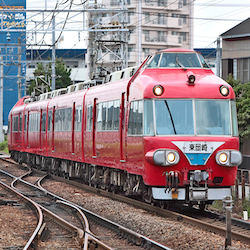Aug 28, 2014
How to Use Meitetsu Trains from Nagoya Station
 There are many great reasons to live in Nagoya. One reason is that, being in the centre of the country it is a magnificent hub of public transportation and from Nagoya you can get to absolutely anywhere in the country. The train systems are particularly convenient.
There are many great reasons to live in Nagoya. One reason is that, being in the centre of the country it is a magnificent hub of public transportation and from Nagoya you can get to absolutely anywhere in the country. The train systems are particularly convenient.
Nagoya is served by three main train lines: JR (including the Shinkansen bullet train), the Kintetsu line and Meitetsu line. The former two are like pretty much anywhere else in the world: multiple platforms, you wait for your train and hop on board when it arrives. The Meitetsu, however, is another kettle of fish all together.
While it has four separate platforms, the train traffic is much greater than you would expect for a station of its comparative diminutiveness (being under the Meitetsu shopping centre it is relatively small and it is not possible to enlarge it). To counter this, many trains stop at each platform – often at a rate of every two or three minutes – which could be extremely confusing when you consider that the trains can go, not only in various directions, but also at different speeds, stopping with greater or lesser frequency.
Getting on the right train
On each Meitetsu platform in Nagoya station there are various positions for passengers to queue up. These are outlined on the ground by colour-coded markings, designating precisely where each train will open its doors (Meitetsu line drivers are trained to stop with remarkable accuracy).
 Where on the platform does each train stop?*
Where on the platform does each train stop?*
Platform No.1 (for Ichinomiya, Gifu, Iwakura, Inuyama, Shin-Kani, Kagamihara, Tsushima and Saya)
Blue Spot – Rapid Ltd. Exp., Limited Express, Rapid Express, Express and Semi Express trains for Ichinomiya and Gifu (via Sukaguchi, Shin-Kiyosu and Konomiya)
Yellow Spot – Local trains for Sukaguchi and Konomiya
Green Spot – Rapid Express, Express and Semi Express trains for Shin-Unuma, Inuyama, and Shin-Kani (via Iwakura and Konan)
Light Blue Spot – Local trains for Iwakura and Inuyama
Purple Spot – Rapid Express, Express, Semi Express and Local trains for Tsushima, Saya and Yatomi (via Sukaguchi)
Platform No.2 (for Ichinomiya, Gifu, Inuyama, Shin-Unuma, Shin-Kani and Saya)
Platform No.3 (for Toyohashi, Toyokawa-Inari, Tokoname, Central Japan International Airport, Kowa and Utsumi)
These platforms are used only for passengers with seat reservation for a μSky Limited Express, a Rapid Limited Express and Limited Express and for arrival.
Platform No.4 (for Higashi-Okazaki, Toyohashi, Toyokawa-Inari, Tokoname, Central Japan International Airport, Kowa and Utsumi)
Blue Spot – Rapid Ltd. Exp., Limited Express, Rapid Express, Express and Semi Express trains for Higashi-Okazaki, Toyohashi, Toyokawa-Inari and Kira-Yoshida (via Narumi, Chiryu and Shin-Anjo)
Yellow Spot – Local trains for Toyoake, Chiryu and Higashi-Okazaki (via Horita and Narumi)
Green Spot – Limited Express, Rapid Express and Express trains for Central Japan International Airport, Kowa and Utsumi (via Otagawa)
Light Blue Spot – Local trains for Oe and Otagawa
Quick and easy
Remembering the above details is extremely beneficial, particularly when running late, as it means that you can just head directly to the right coloured queue. However, unless you have the memory of an elephant, it isn’t necessarily practical. Whenever I take the Meitetsu line, either using my smartphone or on my home PC, I usually check the website Hyperdia, perhaps the best and easiest website for checking train times all over Japan. This will bring up the time and line I am to take.
Then, once I find the correct platform I can check the screens displaying departure times. These screens display, as well as times, what kind of train it will be (from the speediest μSky Limited Express via Rapid Limited Express, Limited Express, Rapid Express, Express Semi Express to the local train), as well as which colour queue to join and how many carriages the train contains.
The latter is also of importance because, as you stand, waiting in the right coloured queue, on the right platform, there is a possibility that, if the train isn’t long enough, it won’t stop in front of you. At peak times, this will be obvious as, if you are the only one in the queue, you’re probably in the wrong one. However, there is a more surefire way to tell. On a wall opposite the platform, there are a row of coloured lights with destination names.
As you can see from the above picture, if you are standing in the blue queue going to Toyohashi, or in the green queue on the way to Central Japan Airport, you are in the right place. If you are in the light blue queue and want to head to Oe, it is best you find another queue. The train won’t be stopping here.
And there you have it, while it looks quite confusing, the Meitetsu line can be pretty straight forward actually. Happy travelling!
*Platform information taken from Wikipedia
By Mark Guthrie
Lead image: By Tennen-Gas (Own work) [GFDL (http://www.gnu.org/copyleft/fdl.html) or CC-BY-SA-3.0 (http://creativecommons.org/licenses/by-sa/3.0/)], via Wikimedia Commons





About the author